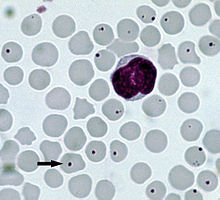Anaplasmosis
| Anaplasmosis | |
|---|---|
 | |
| Anaplasma centrale infecting the red blood cells of a cow: The arrow points to typical infected cell. | |
| Specialty | Veterinary medicine |
Anaplasmosis is a tick-borne disease affecting ruminants, dogs, and horses,[1] and is caused by Anaplasma bacteria. Anaplasmosis is an infectious but not contagious disease. Anaplasmosis can be transmitted through mechanical and biological vector processes. Anaplasmosis can also be referred to as "yellow bag" or "yellow fever" because the infected animal can develop a jaundiced look. Other signs of infection include weight loss, diarrhea, paleness of the skin, aggressive behavior, and high fever.[2]
Many different tick species can carry the bacteria that cause anaplasmosis. The two major bacterial pathogens are
While there are no current live or inactivated vaccines effective for all strains of A. marginale approved by the USDA for anaplasmosis, there are other means of prevention. Tick and fly control for herds of ruminants can be effective but also labor intensive. Chemical methods can also be used, including sanitizing surgical equipment after each use.[3] Tetracycline drugs are the most common treatment for anaplasmosis, and can provide the animal with immunity for a period of time.[7] The disease is more common in the South and West parts of the United States, but is no longer considered a major problem since the use of tetracycline drugs.[8]
Transmission
Mechanical and biological vector transmission work in different ways but both lead to infection of the red blood cells. Mechanical transmission happens in two ways, one when red blood cells are inoculated with the blood parasite through surgical equipment including needles, dehorners, ear taggers, castrating knives, and tattoo instruments. Another mechanical transmission mode is through the mouthparts of biting flies who carry an Anaplasma species of blood parasite.[2]
Biological vector transmission is through ticks that carry a blood parasite able to cause anaplasmosis. The most common Anaplasmosis-causing tick is Ixodes scapularis, also known as the black-legged tick or the deer tick.[9][10] Ticks who contain species of many different Anaplasma species can transmit this disease through a bite. The blood parasite survives and can multiply in the tick, and can sit dormant for months without being transmitted to an animal. When bitten by a tick carrying a blood parasite, the blood parasite can then enter the new host and cause infection.[2]
Once infected with a species of Anaplasma, the parasite multiplies in the blood stream and attaches to red blood cells. The immune system will attempt to kill the infected blood cells but will also kill uninfected red blood cells in the process. The number of red blood cells being destroyed becomes larger than new red blood cells being made, causing the host to become anemic and leading to many other symptoms. Once infected with anaplasmosis, the cattle will always be a carrier of the infectious disease, and calves born from carriers will also carry the disease.[2]
Signs and symptoms
Classic signs and symptoms of anaplasmosis will not occur until 3–6 weeks after infection.
All cattle are susceptible to infection by Anaplasma marginale, but the severity worsens with age increase. Older cattle tend to exhibit the most severe clinical symptoms; cattle aged 1–3 may also show severe symptoms but are able to recover easier.[11]
Causes
The two major species that cause anaplasmosis in ruminants include
- Cattle:
- Sheep and goats:
- Anaplasma ovis – found worldwide.[13] There is a prevalence of 82.9% in sheep, and 74.9% in goats. This species is the most prevalent for causing anaplasmosis in sheep and goats, although Anaplasma phagocytophilium can also cause the disease. Anaplasma phagocytophilium has a prevalence of 11.9% in sheep, and 15.2% in goats.[14]
Morphology
There are many strains of
Prevention
Currently, no live or inactivated
Treatment
The most common source of treatment is the use of tetracycline drugs (including
Epidemiology
In the United States, anaplasmosis is notably present in the South and West, where the tick hosts
In 2005, A. ovis was found in reindeer populations in Mongolia.[16] This pathogen and its associated syndrome (characterized by lethargy, fever, and pale mucous membranes) was previously observed in only wild sheep and goats in the region, and is the first observed occurrence of A. ovis in reindeer.[citation needed]
In Australia, bovine anaplasmosis, caused by A. marginale, is found in only the northern and eastern parts of Australia where the cattle tick is present. It was probably introduced as early as 1829 by cattle from Indonesia infested with the cattle tick
The veterinarian George P. Broussard of New Iberia, Louisiana, conducted important research on anaplasmosis and brucellosis.[18]
References
- ^ "Anaplasmosis". Pennsylvania Game Commission. Archived from the original on 2022-05-24. Retrieved 2021-11-29.
- ^ OCLC 1200163698.
- ^ PMID 21040509.
- ^ PMID 15146989.
- ISBN 9780470961186.
- ^ PMID 35876693.
- ^ a b "Anaplasmosis – Circulatory System". Merck Veterinary Manual. Retrieved 2021-11-14.
- ^ PMID 29581163.
- ^ "Transmission | Anaplasmosis | CDC". www.cdc.gov. 2019-01-11. Retrieved 2019-04-02.
- ^ "Anaplasmosis | ALDF". www.aldf.com. Retrieved 2019-04-02.
- ^ "Keep a watchful eye out for anaplasmosis in cattle herds — Division of Agricultural Sciences and Natural Resources". www.dasnr.okstate.edu. 6 July 2016. Retrieved 2021-11-16.
- ^ S2CID 14218282.
- ^ ISBN 9780323357975.
- ISSN 0921-4488.
- ^ Anaplasmosis reviewed and published by WikiVet, accessed 10 October 2011.
- S2CID 26942337.

- ^ "Bovine anaplasmosis". Tick fever. Department of Agriculture, Fisheries and Forestry, Queensland Government. Retrieved 14 June 2012.
- ^ "George Patout Broussard", A Dictionary of Louisiana Biography, Vol. 1 (1988), Louisiana Historical Association publication, p. 114.
